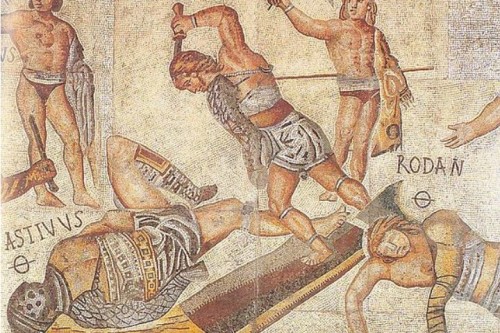
What was a Gladiator?
A gladiator was a professional fighter in ancient Rome who fought in public for a living. These fights were held in large arenas build throughout ancient Rome. The most famous one being the Flavian Amphitheatre now called the Coliseum which had thirty to fifty thousand spectators. Gladiator fighting usually ended with a death due to their aggressive combat lifestyles. Because their life expectancy was so short, many of them lived a glamorous life style until they were freed or died in fighting. Prior to their glamorous life as a gladiator, most gladiators were slaves and condemned prisoners. This type of entertainment without a doubt was one of ancient Rome’s most popular forms of entertainment. Today in modern times, we would consider this type of entertainment barbaric and unjust, but the ancient Romans found this type of entertainment normal. Many of the emperors would use gladiator fighting as a way to keep their popularity up.
Gladiators most often came from a criminal or slave backgrounds. However, it should also be noted that many of them were also prisoners of war who were forced to become a gladiator. It has also been found that bankrupt aristocrats would become gladiators as this gave them a chance to make a living by the sword.
Because these gladiator fighters were so popular throughout the Roman world, Emperors and the wealthy aristocrats used these forms of entertainment to their advantage—politically and socially. It gave the Emperors a chance to display their enormous wealth to the public, commemorate military victories, mark visits from important officials, celebrate special events such as birthdays or festivals, or simply to distract Roman citizens from political and economic problems in ancient Rome. Not only did the emperors of Rome take advantage of gladiators, so did aristocrats as they had immense wealth and also used them for political gain. In ancient Rome, good entertainment was a way of building popularity as citizens’ loved lavish barbaric entertainment.
The word gladiator comes from the word gladiatores in reference to the type of weapon they used; the gladius which was a short sword famously found in ancient Roman times. Even though gladiators did use the gladius at times, a majority of them used a wide range of weapons. They also wore various pieces of armor and helmets. Many of these were very intricately designed and masterpieces in their own right. They were elaborately designed with decorative motifs set with exotic features from peacocks and ostriches on their crests.
Weapons and armor were of huge importance in gladiatorial games. Gladiator armor and weapons were classes based like much of ancient Rome. There were four classes: The Samnite class, the Thracian class, the Myrmillo class, and the Retiarius class. See the table below to get a better understanding of each class and how they were different from each other. To make the fight fair, gladiators were selected to make the fight fair. Some of them were much slower due the heavy armor and others were fast because they did not have much armor weighing them down. Furthermore, there were many different types of gladiators with different combinations of weapons and armor and their names changed over time. Besides the typical gladiator there were some who were archers, boxes, and ones who fought animals called bestiarii.
| Class | Descriptions |
| Samnite | Came from warriors that Rome had fought and beaten in the early years of the Republic.
· Most heavily armed of the gladiators. · Had a sword or lance to fight with. · Large square shield (scutum). · Protective armor on his right (sword) arm and left leg. |
| Thracian | · Curved short sword (sica).
· Very small square or round shield (parma) held in the fist to deflect blows. |
| Myrmillo | · Sometimes known as the fish man.
· Had a fish-shaped crest on his helmet. · Carried a short sword and large square shield (scutum). · Armor only of padding on arm and leg. |
| Retiarius | · No helmet or armor.
· Padded shoulder piece. · Carried a weighted net to entangle opponent. · Once opponent was entangled, he would stab him with a trident. |
Winning was a matter of life or death for these gladiators in ancient Rome. A losing gladiator would have to appeal for mercy by dropping his weapon and shied and raising his finger to his adversary. His adversary could be nice and let him live to see another fight or he could kill him. If he let his opponent live he risked of battling with him again. Therefore it was considered good practice to eliminate your opponent. If the emperor was present at the games he would make the final decision. Most emperors found it was popular to let the crowd decide as this gave them popularity.
A victory meant a lot of things to a gladiator. They were given material rewards, a prestigious palm branch of victory, possibly a crown, money, and even freedom if they had years of victories. Besides being victorious many of the gladiators were very popular with the wealthy women of ancient Rome. Many of these divorced women of wealthy status would have affairs with these gladiators. These gladiators became known as the darlings of the crowds.
Christianity would finally put an end to this savage form of entertainment even though it was part of ancient Roman society. Gladiator fights also ended under barbarian Emperor Honorius in 404 AD. According to historical records, a monk at the time name Telemachus ran into the arena to stop two gladiators from fighting. In the end, Telemachus the Christian monk was killed. There is much speculation as to how he was killed. However, his actions would be attributed to making the emperor put an end to this form of violent entertainment.
Click on the below topics to explore and learn more about the Ancient Roman gladiators and how influenced Roman culture!

